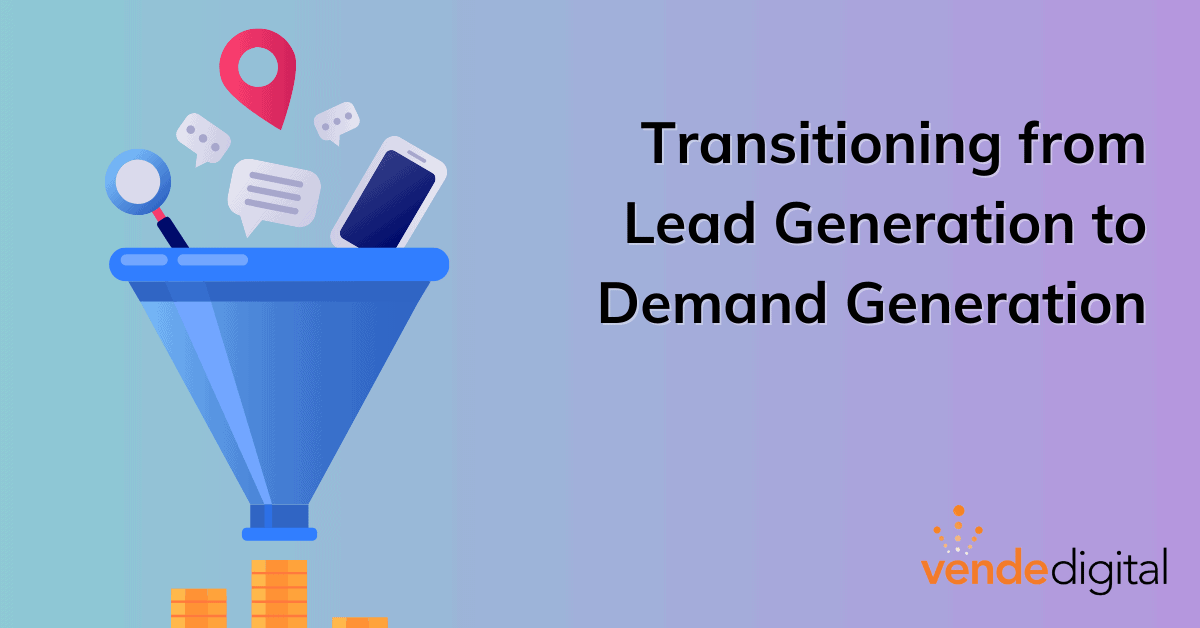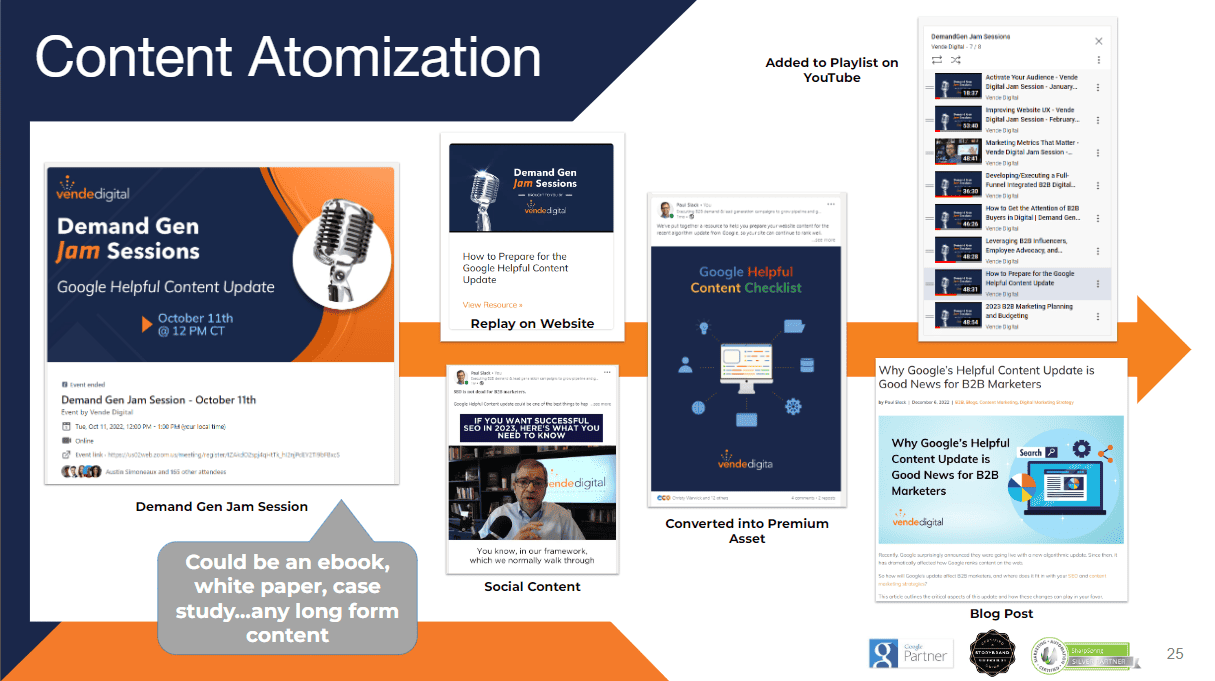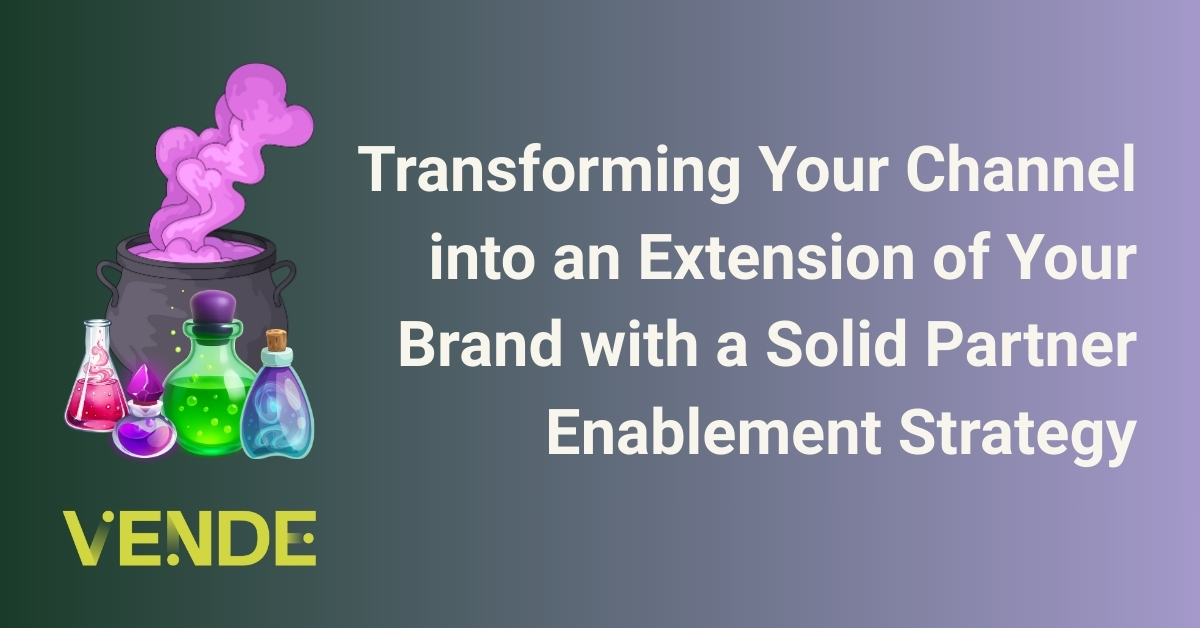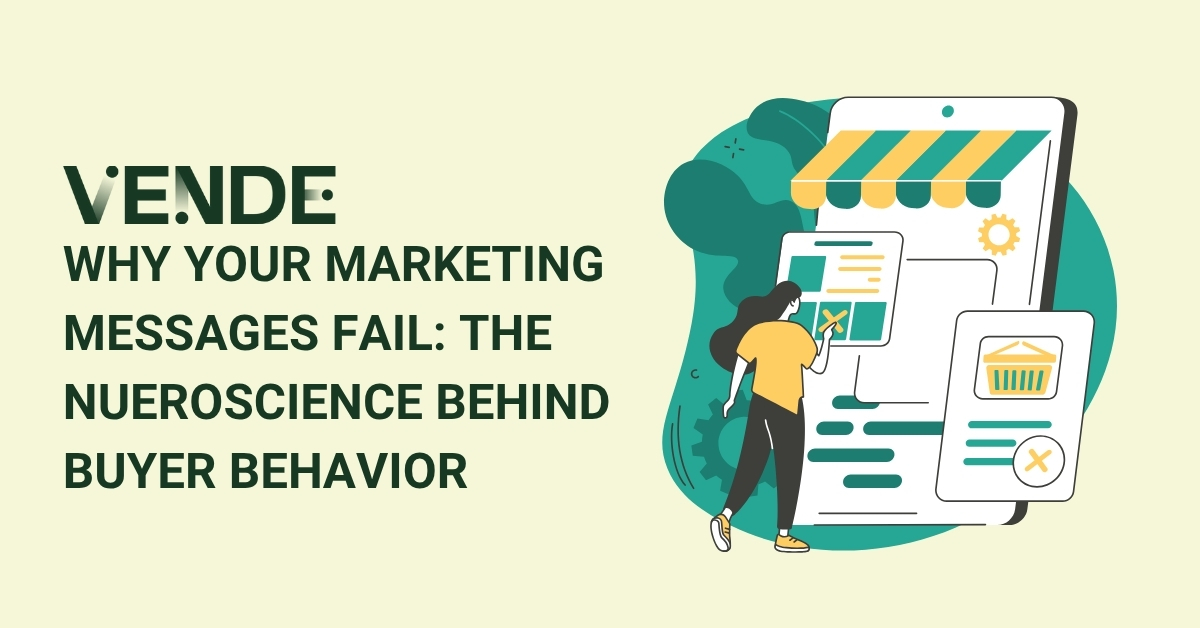
Making the Shift: How to Transition from a Lead Generation Focus to an Integrated Demand Generation and Lead Generation Strategy
As a B2B marketing leader, generating leads is crucial for driving sales and revenue. However, running paid ads to generate MQLs and ebook downloads isn’t enough to sustain long-term growth and success. To truly thrive, B2B companies must transition from a lead generation focus to an overarching demand generation strategy.
If you're feeling that what was once a successful lead generation strategy is starting to plateau or if CPCs/CPLs are growing while performance isn't keeping up with expectations - it's time to start thinking outside the box! Now is the time to implement demand generation marketing into the mix as a new way to achieve success.
For some B2B marketers, the thought of transitioning from lead generation to demand generation can be a daunting prospect. But it doesn't have to be an all-or-nothing proposition; rather than diving in headfirst, taking small steps and testing the waters before committing fully is often more effective. This way, you'll reduce errors that could cost time or resources, as well as increase your odds of success!
What are the Benefits of Demand Generation?
Demand generation is focused on your future buyers and on generating demand for your product or services long-term. Executing an effective Demand Gen strategy will lead to an improvement in your B2B marketing results in these four key areas:
- You will build a bigger pipeline.
- Your opportunity to close rates will dramatically increase.
- You will attract higher deal sizes due to less competition.
- You will close deals faster because the buyer will already know how you can help them.
Why is Integrating a Demand Generation Marketing Motion Important?
The best tactics for generating interest in your solutions are the ones that match your prospect’s behavior and support their buying journey. But what if your buyer's behavior is shifting?
Well, your old tactics will fail to generate the leads you want.
The reality is that many B2B marketers are applying outdated lead generation tactics and are missing valuable opportunities to create exposure for their brand and generate higher-quality leads.
And this is precisely what is happening. There has been a massive shift in B2B buyer behavior, including how buyers search for information, evaluate and engage with your company.
In B2B Marketing, we can't control when buyers are ready to buy, but we can control whether they think of your company first when they are prepared to.
And this is a long game!
LinkedIn and Ehrenberg-Bass Institute did a joint research project called "How B2B Brands Grow" and discovered that only 5% of customers are ever in the market for what you are selling, and it can take years before a future buyer makes a purchase.
And a shortlist game!
According to the Harvard Business Review, 85% of B2B buyers have a shortlist of 4-5 prospective vendors before they begin shopping for solutions - and end up buying from one on that list 90 percent of the time. That means if you're not already present in their minds before their purchase process starts, your chances of success are slim. Demand Generation is key to grabbing attention and ensuring your company ends up on their shortlists!
Therefore, taking a long-term approach will reap better results and ensure that you stimulate growth and capture your future buyers.
Demand Gen and Lead Gen Work Best Together
You've heard these two terms repeatedly, but what are the key differences between the two? Here is a definition to help you understand the differences:
- Lead Generation focuses on attracting (5%) customers in the market now.
- Demand Generation focuses on creating a sustained demand for your products or services by engaging with (95%) of your future buyers before they are in the market.
While lead generation is essential to the demand generation process, it is just one piece of the puzzle. Primarily relying solely on Lead Gen will stifle long-term growth.
A successful demand generation marketing strategy takes a comprehensive approach to marketing that includes both Lead Generation, as well as, educating and nurturing prospects over time.
It's not one or the other; it's both. You must create demand for your business and capture demand (in-market customers). What's fantastic is that they are both possible via digital marketing and work best when running together. The reality is that opportunities generated today are the fruits of demand generation from your past efforts. You could say Demand Gen is like farming.
You need to plant your seeds and water your crops before you can expect a harvest. But this takes time and constant nurturing to reap what you sow.
Planting seeds alone does not guarantee you will yield a crop. Your efforts need to be consistent and focused on nurturing the right things to reap the rewards in the long term.
On the other hand, only planting without harvesting means others will reap your harvest. But when you do both, the harvest will be plentiful, and you will reap the full benefits of demand and lead generation.

7 Steps to Transition from Lead Gen to Demand Gen
Now that you understand the differences, you might wonder how to implement this in your organization. Let's review simple steps to integrate Demand Gen into your marketing efforts.
Step One: Start by Selling It to Your Leadership
Getting management buy-in can be challenging when introducing a demand generation strategy. To give yourself the best shot:
- break the process down into "Crawl," "Walk," and "Run" stages
- use external data to show buyer behavior changes
- be ready to overcome anticipated objections.
Explain each stage in detail and propose starting with "Crawl" for low risk and quick results.
Step Two: Listen to Customers
To craft messaging that will strike a chord with potential buyers, gaining insights into their challenges and choices is essential. To gain these insights into their needs, speak with existing customers. By asking them the questions listed below, you'll receive a wealth of information to help shape your strategies:
- What made you realize you needed our solution? (Understand what made them make their decision).
- What problem were you experiencing at the time? (Get to the core reason that made them make a decision).
- What held you back from making a purchase decision? (Understand what stopped them from committing to your solution).
- What alternative would you have chosen to our solution? (Find out which of your competitors they considered).
- What do you love about our product or service? (Understand what feature or benefit is most valuable to them and why).
- How has our product or service changed your situation? (This is prime testimonial feedback).
- How would you describe our product or service to someone in your position? (This feedback can help you speak to your target customer better).
Use these insights to understand their needs, challenges and what they value to fine-tune your Demand Gen activities to better serve your customer.
Step Three: Build a Content Marketing Flywheel
Content marketing is key to getting these insights in front of prospective customers. By leveraging a content flywheel, you'll have a consistent stream of content that aligns with your company's goals, and you won't have to come up with new ideas all the time. Plus, you'll produce much more content with less effort.
- Start with 3-5 content pillars that answer the question: What do you want to be known for? Then, build long-form foundational content around those pillars, such as guides, webinars, podcasts, interviews, and blog posts.
- Next, repurpose that content into different formats, such as turning an article into a podcast episode or video, or vice versa. You can also create shorter, more consumable content like blogs, cheat sheets, and checklists.
- Finally, break down your content into bite-sized chunks for social media.

By using a content marketing flywheel, you can create an unlimited amount of content that generates demand and fuels your growth over the long term.
Step Four: Stop Gating Your Content with Lead Gen Forms
B2B marketers are obsessed with gating content and lead gen forms. Yes, they can work, but modern buyers expect that information to be freely available without giving up their contact information.
B2B buyers want free access to information. The more you make it available to them, the more they will consume. And if you don't, they will search for companies making their resources available.
Ungate all of your guides, webinars, and resources. It might seem counterintuitive to give all your best resources away, but locking them up behind a form isn't helping your customers, and it isn't helping you either.
Step Five: Get SMEs Actively Posting on LinkedIn
As B2B marketers, we all want to leverage greater results with fewer resources. And one way to do this is to encourage employee advocacy. This means involving your employees in social media and letting them grow as influencers in their industry and field.
Why? Because people buy from people they know, like, and trust. And your employees can become the people your buyers trust and, in turn influence them to trust your brand.
Step Six: Build a Community
Sharing what your company is doing in public is a great way to attract attention. It can build curiosity about your product or service and motivate customers to share their needs and challenges.
And this can help your team gain valuable insights into how you can refine and improve your solution for your customers while creating demand for it.
If you’ve noticed what is happening in B2B marketing and demand generation…
MQLs are dying.
As mentioned earlier, you just can’t gate every piece of content to generate leads anymore. But at the same time, you still need to engage buyers in the middle of the funnel.
Community can be the answer.
It’s time to start building a community of customers, prospects, and influencers instead of asking prospects for their email in exchange for an ebook. They want access to your resources and a more intimate experience with your brand.
This is where the world is heading.
Community will be the non-salesy place where B2Bs can connect and engage with customers and prospects while gaining support and exclusive resources.
Step Seven: Develop a New Measuring Stick
Moving away from a lead gen strategy that relies solely on producing MQLs can present challenges, especially when developing new leading and lagging indicators. Demand generation is less about generating leads and more about educating potential customers. This can be difficult to measure because these tactics don't necessarily result in immediate conversions.
To measure the success of your demand gen marketing efforts, adopt a holistic model that considers total expenditures against pipeline and revenue produced rather than focusing solely on conversions from individual channels and tactics.
Holistic KPIs Work Best
For example, one of our clients recently changed from lead generation to demand generation. By attributing nearly $5MM in revenue to merely ~$150K in advertising costs due to our efforts, it was clear that we had achieved success! Any individual tactics deployed may have seemed ineffective at first glance since none of them directly produced leads. However, their requests for proposals skyrocketed because they were continually present with their ICP delivering key messages about how they could help their customers.
In addition, it's important to accurately determine first-touch and last-touch attribution. You'll need to add self-reported attribution to your primary conversion forms on your website to learn from the prospect's own words what created their awareness of your company, such as through LinkedIn or podcasts.
Key Takeaways
- B2B buyers already have a short list of 4-5 vendors in mind and purchase from one of these vendors 90% of the time.
- Lead Gen is focused on your (5%) in-market buyers.
- Demand Gen focuses on capturing your (95%) future buyers.
- Leverage an integrated demand gen and lead gen strategy by:
-
- Listening and learning from your customers.
- Multiplying your content production using a content flywheel.
- Getting your company leadership and employees engaging in LinkedIn.
- Building a community for your customers.
- Adjusting how you track performance to align with Demand Gen activities.
-
By following these steps, B2B companies can transition from a lead generation focus to a demand generation strategy that drives long-term growth and success. By deeply understanding your target audience, creating valuable content, and nurturing leads through the sales process, you can create sustained demand for your products and services.
How Can We Help?
Building a marketing strategy that delivers results is no walk in the park. It’s why we help B2B organizations like yours develop strategies that you can execute.
Tired of struggling to get results?
Schedule a complimentary discovery call with our team to find out how we can help you accelerate your growth and win more customers.







